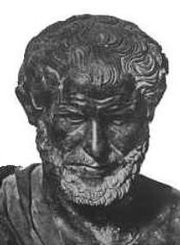Pre-experimental science
|
|
From Antiquity up to the time of the Scientific Revolution, inquiry into the workings of the universe was known as natural philosophy, but this included fields of study which today have been divorced from science. The ancient people of Western civilization who we might think of as scientists may have thought of themselves as natural philosophers. In other cases, systematic learning about the natural world was a direct outgrowth of religion, often as a project of a particular religious community. An account of the development of (natural) philosophy from ancient times until recent times can be found in Bertrand Russell's History of Philosophy.

One important feature of "pre-scientific" natural philosophy is a reluctance to engage in experiment. For example, Aristotle is one of the most prolific natural philosophers of antiquity. He made countless observations of nature, especially the habits and attributes of plants and animals in the world around him, which he devote considerable attention to categorizing. He also made many observations about the large-scale workings of the universe, which led to his development of a comprehensive theory of physics in his missives of the same name. (See Physics (Aristotle).)
But Aristotle did not make predictions in the way that modern scientific theories are expected to. His approach was to observe nature, to use deductive reasoning and inductive reasoning to explain everything, and to use his natural observations to illustrate his explanations. For example, he developed a version of the classical theory of the elements (earth, water, fire, air, and aether). In his theory, the heavier elements (earth, water) had a natural tendency to move toward the center of the universe (what we would now call the center of the Earth), and the lighter elements a natural tendency to move away from it. (Aether was what celestial bodies - e.g. planets and stars - were supposedly made of.)
Aristotle could point to the falling stone, rising flames, or pouring water to illustrate his theory. His laws of movement hypothesized that friction was an omni-present phenomenon - that any body in motion would, unless acted upon, come to rest. He also proposed that heavier objects fall faster, and that voids were impossible.
But until the time of the Scientific Revolution, these theories were never really tested experimentally. At the time, the utility of experiment was unproven. Some believed that setting up artificial conditions in an experiment could never produce results that described nature as it was in the world around them.
When investigated experimentally by burning objects in closed spaces, it was eventually determined that air was not elemental. This led to the development of phlogiston theory and later to discovery of the role of oxygen in combustion.
Galileo (1638) investigated the motion of falling bodies, and found that heavier bodies, in fact, do not always fall faster. The experimental results of Copernicus, Kepler and Galileo were formalized in Newton's laws of motion. Newton would state that inertia is an inherent property of mass: a moving body will stay in motion unless acted upon. Unlike Aristotle's views, Newton would state that friction is not an inherent property of objects; friction seems omni-present because we live in an environment filled with fluids like air and water, which maintain continual contact with all objects immersed in them.
Other revolutionary investigations of the period produced the vacuum, a void of the sort that Aristotle thought impossible. Today, one of the results of quantum mechanics is the notion that even vacuum possesses properties (see quantum foam) which were unsuspected during the time of the Scientific Revolution.
Aristotle's predecessor, Plato (c. 427 BC ? c. 347 BC), was similarly non-experimental. Plato studied the phenomenon of refraction. Due to changes in velocity, light changes its path when it passes from one material to another with a different index of refraction, such as from air to water or from water to glass. He formulated a law to describe the relationship between the angle of incidence and the angle of refraction (what we might think of now as the incoming and outgoing light beams). He even formulated a procedure by which one might measure these angles in various situations, involving a basin of water or a piece of glass. In his treatise, he helpfully supplies a table which shows how the observed angles match exactly what his law predicts. It is likely, however, that Plato never actually performed his thought experiment, because he would not have gotten the results he reports (which are an exact match, down to the last decimal place, to his theory). Plato's theory of refraction is actually quite incorrect, and differs by an easily detectable amount from the modern theory of refraction. He essentially used his "experiment" as an illustration of his theory, not as a test of its validity. His assertions, like those of Aristotle, went untested by his peers and remained unchallenged for centuries. It was the Egyptian scientist Ibn al Haythen (known in Western Europe as Alhazen) (965-1040), who finally discounted it with a mixture of logic and experimentation. His studies of light, published in the book "Optics" in 1015 to 1021, during the era of the Moorish Empire, are possibly the earliest work to use the scientific method and were very influential in later studies of light. It was translated into Latin around 1270, which brought this knowledge to Western Europe. Other Arab scholars influenced the development of science in similar manner, be it through their own work or through the works of Antiquity that the Arab world preserved.

